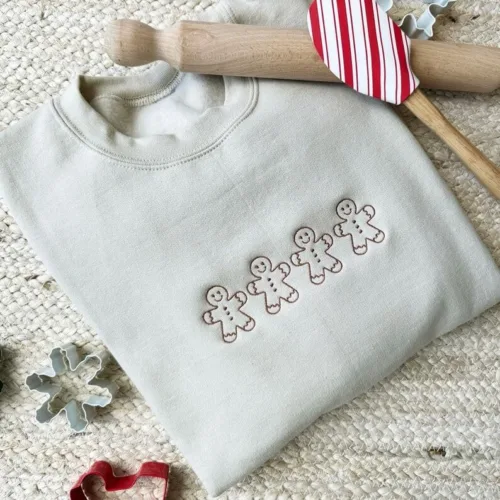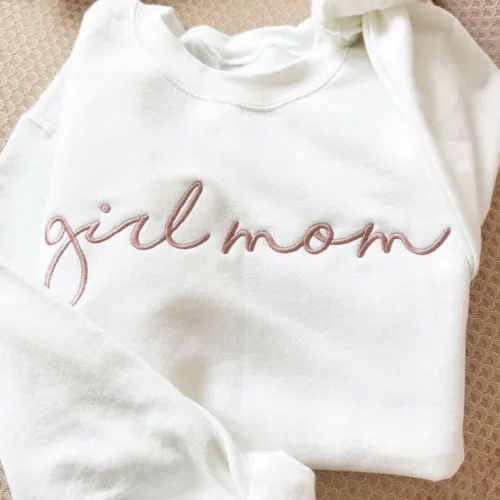The best discounts this week
Every week you can find the best discounts here.
Personalized Embroidered Hat, Custom Text, Custom Logo, Custom Your Image
Personalised Vintage Cap – Custom Embroidered Unisex Cotton Dad Hat with Personalized Text
Personalized Embroidered Cat Hat, Custom Dog Hat, Custom Hat Vintage Baseball
Custom Embroidered FAITH Crewneck Sweatshirt
Gingerbread Men Embroidered Sweatshirt
Girl Mom Personalized Crewneck Sweatshirt
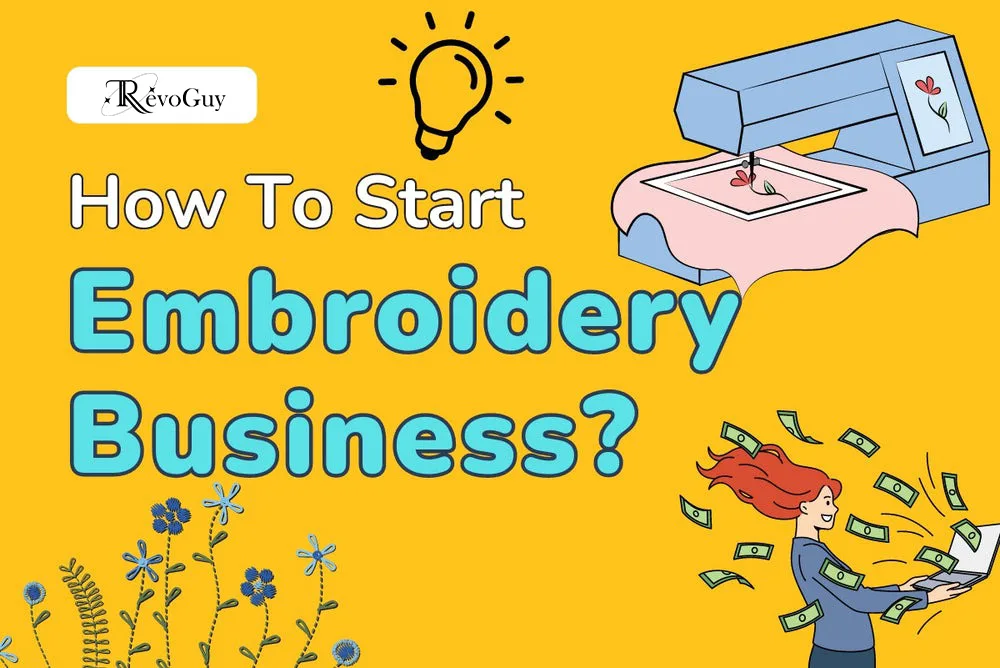
Table of Contents
For many years, the embroidery industry has experienced a renaissance, driven by technological innovations, evolving consumer preferences, and a growing range of market applications.
Today, embroidery is not only surviving but thriving by adapting to modern needs, opening up a wealth of opportunities for entrepreneurs. With its versatility, embroidery has found its place in diverse sectors, including custom apparel, corporate branding, home décor, and personalized gifts. This adaptability has made it a key player in the modern textile industry.
This guide aims to provide you with a comprehensive roadmap to starting and managing a successful embroidery business. Drawing from the experiences of established companies like Embroly, we will walk you through the essential steps to navigate the embroidery world, offering practical insights and strategies for success.
Embroidery for Beginners
Embroidery has a long and rich history, with roots stretching back thousands of years. The evolution of this craft has seen it transform from an intricate hand-stitched art form into a versatile technique supported by modern machinery. For anyone looking to start an embroidery business, understanding the history, styles, tools, and techniques is essential to lay a strong foundation.
Here’s a breakdown of the key knowledge to get started:
- History of Embroidery
- Embroidery Classification & Styles
- Embroidery Tools and Materials
- Type of stitches (e.g., satin stitch, chain stitch) and techniques (e.g., appliqué, 3D, digitizing,…)
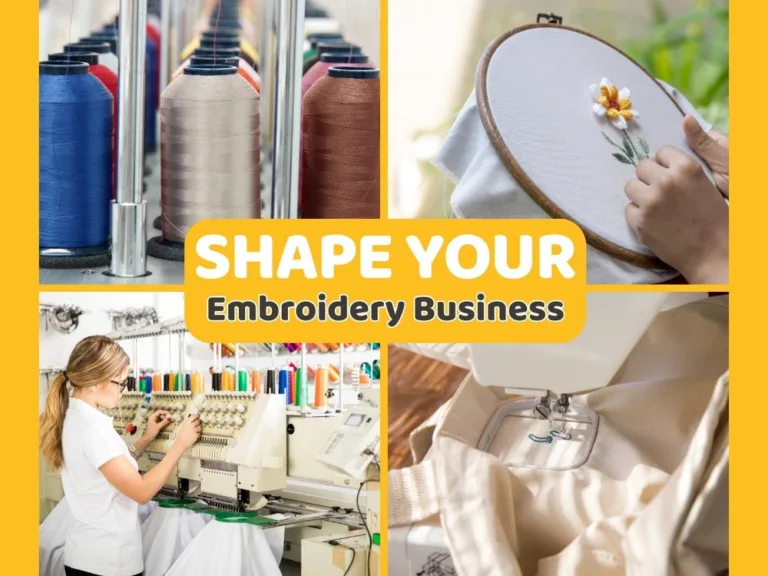
Embroidery Business Types
Choosing the right direction for your embroidery business is a crucial first step. The model you select should align with your interests, budget, and long-term vision for growth:
DIY Embroidery
This approach suits beginners and hobbyists aiming to turn passion into profit. Operating from home, you’ll focus on crafting one-of-a-kind embroidered items. Key advantages include:
Minimal initial investment
Freedom to set your own schedule
Access to customers via online shops or craft fairs
Keep in mind, growth may be slow, and output is often restricted by time and capacity.
Expert Embroidery
For entrepreneurs targeting business expansion, the professional embroidery model provides scalability and broader market reach. This setup typically includes:
Purchasing high-capacity, industrial embroidery equipment
Serving clients with bulk orders (e.g., branded apparel, team uniforms)
Catering to retail chains or running your own branded product line
Although the startup investment is higher, this path offers increased output, brand recognition, and stronger revenue potential.
Sell Embroidery Online
The online model opens up exciting possibilities for launching an embroidery business with limited upfront investment. This approach typically includes:
Creating a digital storefront through platforms like Etsy, Shopify, or your own website
Partnering with print-on-demand services such as Printful, Printify, Senprints, or Gelato
Offering custom embroidered products that are produced and shipped only when ordered
Key advantages of this model:
Minimal startup and inventory costs
Flexibility to experiment with designs and niches
Access to a broad, international audience
Ultimately, your business model should align with your goals, skills, and available resources. Many embroidery entrepreneurs start small and adapt over time—some shift between models, while others blend approaches to maximize both creativity and profitability.
Demand for Embroidered Products
Gaining an understanding of the embroidery market landscape is a crucial step before starting your business. Recent market trends indicate a flourishing industry with considerable opportunities for growth and innovation.
Embroidery Market Insights
The embroidery market is undergoing significant growth, largely fueled by the booming textile and apparel industries. Several factors are driving this expansion:
- Growing Demand: Embroidered fabrics are sought after across diverse sectors, with high demand in fashion, home décor, and corporate branding.
- Regional Growth: The Asia-Pacific region is set to dominate the market, particularly in countries like India, where the home décor market is growing by 20% annually. North America is also experiencing growth, especially within the hospitality industry.
- Perceived Quality: Embroidery is considered a high-quality, durable method, adding considerable value to products and enhancing their appeal.
preferences source: fortunebusinessinsights.com
Understanding Market Potential
When considering profitable niches for your embroidery business, focus on these key areas:
Fashion: Apparel remains the leading application for embroidery, with demand for intricate designs in clothing, from casual wear to haute couture.
Corporate Branding: There’s a growing need for embroidered uniforms, promotional items, and linens, especially in industries like restaurants and retail.
Home Décor: Embroidered household textiles, including curtains, tablecloths, and bed linens, are in high demand, driven by consumer interest in personalized and decorative home accents.
Personalized Gifts: Custom embroidery on gifts such as towels, bags, and clothing is a rapidly growing market, fueled by the trend for unique and meaningful presents.
Hospitality Sector: Hotels, restaurants, and other hospitality businesses require embroidered linens, uniforms, and accessories, creating a consistent market opportunity for bulk orders.
High-Demand Product Identification
As you plan your product line, consider incorporating these popular items that consistently perform well in the embroidery market:
T-shirts and Polo Shirts: Custom designs on these items are always in demand for both personal and promotional use.
Hats and Caps: Embroidered logos or designs are popular for sports teams, companies, and casual wear.
Hoodies and Sweatshirts: Embroidery adds a stylish, premium feel to casual clothing, making it a great choice for both retail and custom orders.
Tote Bags: These functional items offer ample space for custom embroidery, making them a popular choice for gifts or promotional items.
Towels and Bathrobes: Personalizing towels or bathrobes with names or logos makes them great for hotels, spas, or gifts.
Corporate Uniforms: Embroidered company logos on uniforms enhance professionalism and brand identity.
Sports Team Apparel: Custom embroidery is perfect for team uniforms, from jerseys to jackets, supporting team spirit and identity.
Household Linens: Items like pillowcases, table runners, and napkins provide a great opportunity for customization, appealing to homeowners looking to add a personal touch to their home décor.
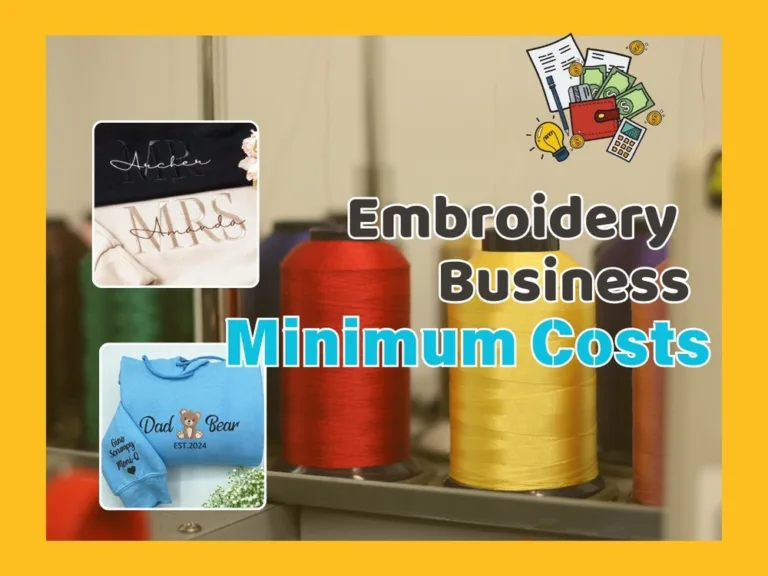
Embroidery Business Budget Essentials
These steps of your embroidery business journey require a clear understanding of the initial investment required. Let’s break down the essential costs you may need to consider for the three mentioned business models:
Homemade Embroidery
This model offers the lowest entry cost, typically ranging from $500 to $5,000. It includes a basic embroidery machine suitable for home use, essential software, and initial supplies such as threads, fabrics, and needles. This setup is ideal for hobbyists or those just starting on a small scale. Since it’s home-based, the operating costs are also low, giving you flexibility and room to grow at your own pace.
Professional Embroidery
For those looking to run a more extensive operation, you can expect to invest from $15,000 upwards. This investment includes commercial-grade embroidery machines (such as models from Tajima or Melco), professional software like Wilcom Studio, and a wider range of high-quality supplies. This setup allows for higher production capacity, enabling you to take on larger orders and more complex designs. The investment may also involve renting or leasing workspace, which is necessary for scaling the business.
Online Platform Embroidery Business
Starting an online embroidery business can have a lower initial investment, typically ranging from $1,000 to $3,000. This cost covers the creation of an e-commerce website, basic design software, initial inventory, and marketing efforts. Additionally, you would often rely on third-party fulfillment platforms (like Printful or Printify), which requires fees for product manufacturing and shipping. While the upfront investment is relatively low, you’ll need to factor in ongoing operational costs like platform fees and potential lower profit margins due to outsourcing production.
Each model has varying levels of investment, which depend on the scope and goals of your business. Whether starting from home, scaling professionally, or setting up an online platform, understanding the associated costs is key to creating a sustainable business.
Cost Guide for Embroidery Equipment
Your choice of equipment will play a key role in determining your startup costs. Here are the options to consider:
- Entry-Level Machines: These are perfect for home-based businesses and are priced between $500 and $5,000. They are ideal for small orders and basic designs, making them an affordable option for beginners.
- Semi-Professional Machines: These machines are suited for small to medium operations and range from $5,000 to $15,000. They offer more features, faster speeds, and greater customization, allowing you to handle a higher volume of work with improved efficiency.
- Industrial Machines: Designed for large-scale production, industrial-grade machines can cost between $15,000 and $50,000 or more. They are built for high-volume production, capable of handling complex and large designs with high precision.
Alternative Option: To minimize initial investment, you might consider using third-party platforms or outsourcing embroidery work. This allows you to avoid the high upfront costs of purchasing equipment, as these platforms handle the production for you.
Understanding Operating Expenses
When managing the financials of your embroidery business, consider these ongoing expenses:
- Materials: This includes all supplies like thread, fabric, stabilizers, needles, and any other components necessary for production.
- Utilities: Running machinery and maintaining an operational workspace will incur utility costs such as electricity, internet, and possibly water.
- Maintenance and Repairs: Regular servicing and repair costs for embroidery machines and other equipment ensure smooth operations.
- Labor: If you hire additional help for production, customer service, or other tasks, be sure to include wages, taxes, and benefits in your budget.
- Marketing and Advertising: To reach a broader audience, set aside funds for advertising, both online and offline, including social media ads, SEO, or print promotions.
If you’re operating solo, you will likely reduce some of these costs, but don’t forget to factor in the value of your time and energy spent on various business operations.
Company Formation and Startup Expenses
Legal obligations differ depending on your area, but typically involve:
- Business formation costs
- Necessary licenses and authorizations
- Business insurance coverage
- Professional legal advice fees
Set aside a budget of $500 to $2,000 for these initial setup expenses.
Embroidery Design Software
Reliable software is crucial for crafting and modifying embroidery designs. Commonly used programs include:
- Wilcom (professional level, $1,000+)
- Hatch (mid-tier, $500–$1,000)
- Embrilliance (beginner-friendly, $150–$500)
If you’re not creating designs yourself, consider the expense of hiring freelance artists (around $5 per file) or purchasing ready-made patterns from online marketplaces.
Carefully estimating these expenses will give you a better understanding of what it takes to start your embroidery venture. Keep in mind, investing in top-notch tools and software often leads to better productivity and higher-quality results over time.
Embroidery Startup Guide
Legal Setup Options
Selecting the appropriate legal framework for your embroidery business is an important step that influences your tax obligations, personal liability, and day-to-day management. Here are a few standard options to consider:
- Sole Proprietorship – Easiest to set up, best suited for solo or home-based businesses.
- Limited Liability Company (LLC) – Provides liability protection while offering flexible tax treatment.
- Corporation – Suitable for larger-scale operations aiming for rapid expansion or investment.
It’s wise to speak with a local accountant or legal professional to choose the structure that aligns best with your goals and local regulations.
Selling Platforms
Expanding your sales channels is a smart strategy to grow your customer base and boost income. Explore these avenues:
- E-commerce Website – Create your own store using tools like Shopify or WooCommerce for full control over branding and customer experience.
- Online Marketplaces – Tap into existing traffic on platforms like Etsy, Amazon Handmade, or eBay to attract niche buyers.
- Social Media Selling – Use Instagram Shopping or Facebook Marketplace to engage followers and sell directly through posts or live streams.
- Wholesale – Collaborate with brick-and-mortar retailers to get your embroidered goods on store shelves.
- Craft Fairs and Local Markets – Engage with customers face-to-face and gather immediate feedback by selling in person.
Each method comes with its own benefits and challenges—consider your resources and audience when deciding where to focus your efforts.
Grow Your Embroidery Sales
In the current competitive environment, strong marketing strategies are crucial for the growth of your embroidery business. Below are some effective tactics to help expand your reach and boost sales:
Promote on Social Media
Utilize popular social media platforms to display your creations and connect with potential customers:
Instagram: Post high-quality images of your embroidered items and share behind-the-scenes content.
Pinterest: Curate boards showcasing your designs along with related inspiration.
TikTok: Create short videos highlighting your embroidery process or featuring finished pieces.
Consistency in posting and using relevant hashtags can help expand your reach and attract more attention to your business.
Search Engine Optimization (SEO)
Improve your website’s visibility by focusing on search engine optimization (SEO):
Incorporate relevant keywords in product descriptions and blog content.
Provide valuable information on embroidery techniques, trends, and tips.
Ensure your website is mobile-friendly and optimized for fast loading speeds.
By enhancing your SEO, you’ll increase your website’s chances of ranking higher on search engines, driving more traffic to your store.
Influencer Marketing
Partnering with influencers can significantly boost your brand’s visibility:
Provide free products in exchange for posts, reviews, or shout-outs on social media.
Create exclusive discount codes for influencers to share with their followers.
Explore long-term collaborations to ensure ongoing brand exposure and loyalty.
This approach helps you tap into established audiences and build credibility within your niche.
Local Collaborations for Growth
Establishing local connections can significantly enhance your embroidery business:
Collaborate with local boutiques to feature your embroidered products.
Provide custom embroidery services to nearby sports teams or schools.
Get involved in community events to increase brand awareness.
By building strong local relationships, you’ll create a loyal customer base and strengthen your brand presence. Regularly evaluate your marketing strategies to ensure they align with your audience’s preferences and needs.
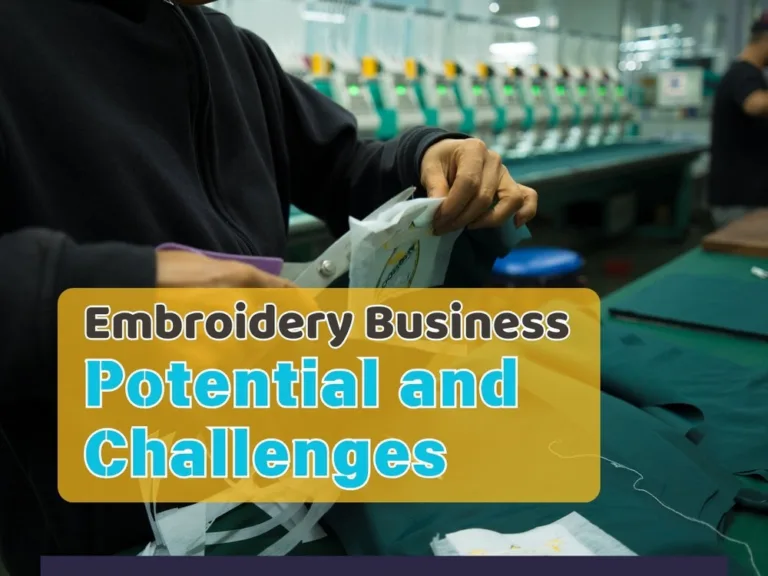
Opportunities and Obstacles in Embroidery
The Profit Potential of Embroidery Businesses
The embroidery sector remains vibrant, presenting various opportunities for business owners. Here’s why:
Strong Consumer Interest in Personalization:
In a world dominated by mass production, there is a growing desire for individualized products. Your embroidery business can meet this demand by creating one-of-a-kind, customized items that make a lasting impression.
Expansive Market Potential:
Embroidery has a broad range of uses, from corporate branding to fashion, offering a wealth of opportunities. This adaptability allows you to explore various industries and diversify your income sources.
Booming Online Sales:
With the surge of online shopping, embroidery businesses now have access to a global audience. This trend enables you to expand your reach and connect with customers from around the world.
Challenges in Embroidery
Tax and Legal Matters
- Intellectual Property Protection: Make sure you have the legal right to use or reproduce designs, particularly when dealing with logos or copyrighted materials.
- Tax Responsibilities: Familiarize yourself with your tax obligations, including collecting and reporting sales tax.
- Regulatory Compliance: Stay informed about local laws and regulations, particularly those relating to home-based businesses or commercial operations.
Employee Management Hurdles
- Skilled Workers: Recruiting and retaining embroidery experts can be challenging due to the specialized nature of the skill.
- Training: It’s essential to invest in training your team to ensure they meet your quality standards and can operate the machines effectively.
- Workplace Safety: Establishing clear safety protocols is vital to prevent injuries from machinery and maintain a safe working environment.
Stay on Top of Embroidery Trends
- Trend Awareness: Keep up with the latest fashion and design trends to ensure your products stay fresh and appealing to customers.
- Technology Updates: Stay ahead of the curve by investing in updated equipment and software to keep your production efficient and innovative.
- Competition: Stand out from the crowd by offering unique designs and personalized services that larger companies and online platforms might not provide.
Key Insights from Embroly
Drawing from Embroly’s journey since 2021, we’ve gained valuable insights into running a successful embroidery business. Our experience offers practical lessons for both newcomers and established entrepreneurs in the industry:
Phased Growth Strategy
We initially focused on custom embroidered sweatshirts, hoodies, and t-shirts. In 2022, we expanded to include hats, tote bags, and polo shirts. This gradual approach allowed us to refine our processes before diversifying our product offerings.
Strategic Design Partnerships
Moving from self-designed products to collaborating with third-party designers expanded our design range while maintaining production efficiency.
Investment in Advanced Technology
We use industry-standard software like Wilcom Studio and operate machines such as Tajima and Melco. This investment has been essential in maintaining our high production standards and product quality.
Streamlined Workflow
Our operations are organized into a clear, seven-step process, from market analysis to customer feedback collection. This structured approach ensures consistency and supports business growth.
Rapid Design and Production
We’ve optimized our workflow to turn designs around in 24-36 hours, followed by thorough quality control and finishing.
Customer-Focused Approach
We emphasize fast delivery (3-5 business days within the US) and actively use customer feedback to improve our services.
Advice for New Entrepreneurs in Embroidery:
- Start with your strengths: Choose products that align with your skills or market demand.
- Financial Planning: Be sure to conduct thorough profit calculations before starting.
- Leverage existing platforms: Gain experience through third-party platforms before heavily investing in equipment and staff.
- Competitive pricing: Initially, use competitive pricing to build market presence, even if profits are lower.
- Scale Gradually: Begin small and scale up as your business grows and you gain experience.
Success in this business requires a mix of creativity, technical expertise, business strategy, and a continuous desire to learn and adapt.
Final Thoughts
The embroidery business landscape offers a unique fusion of artistic creativity and entrepreneurial potential. However, succeeding in this industry demands more than just technical expertise. You will need to navigate challenges like legal requirements, market competition, and shifting consumer trends. By staying informed, adaptable, and committed to delivering high-quality products, you can position your embroidery business for sustainable success.
We encourage you to explore the embroidery business as a viable entrepreneurial opportunity. With the right strategy, dedication, and creative vision, the embroidery industry holds exciting possibilities.
Remember, every prosperous embroidery business began with a single stitch. We hope this guide provides the practical insights necessary for you to embark on your journey into the dynamic world of embroidery entrepreneurship.
FAQs About Embroidery Business
1. What are the startup costs for an embroidery business?
Starting an embroidery business can range from $5,000 to $50,000 or more, depending on your chosen scale and equipment. A basic setup with an entry-level embroidery machine, software, and supplies typically costs between $5,000 to $10,000. More advanced, industrial-grade setups can cost between $20,000 and $50,000. Don’t forget to include additional costs like business registration, marketing, and ongoing material expenses. Starting small and gradually expanding, as Embroly did, can help manage these initial costs effectively.
2. What essential skills do I need to manage an embroidery business?
Although expertise in embroidery helps, it’s not necessary to be an expert yourself. Key skills to manage a successful embroidery business include:
Understanding embroidery techniques and terminology
Proficiency with embroidery software and machinery
Business management, including financial planning and operations
Strong customer service and communication abilities
Marketing and sales know-how
Flexibility and willingness to adapt to new trends and techniques
3. Which products are most profitable in the embroidery business?
Based on market trends and Embroly’s experience, the following embroidered products tend to be highly profitable:
Custom corporate apparel (uniforms, polo shirts)
Personalized gifts (monogrammed items)
Sports team apparel
Home décor items (pillows, table linens)
Fashion accessories (hats, bags)
Hospitality items (hotel linens, restaurant uniforms)
The key to success is to target high-demand, high-margin products and cater to the right niche market.
4. How can I stay competitive against larger or cheaper embroidery businesses?
To effectively compete with bigger companies or cheaper alternatives, focus on the following:
Emphasize quality and craftsmanship, as embroidery is often preferred for its durability and premium appearance
Offer exceptional customer service and faster turnaround times
Specialize in unique designs or niche markets
Leverage your local presence for personalized service
Keep up with the latest embroidery techniques and technologies
Build a strong online presence using e-commerce platforms
Gather and apply customer feedback to continuously improve your services
5. Is the embroidery market oversaturated, or is there room for new businesses?
The embroidery market is competitive, but it’s far from oversaturated. It continues to grow, particularly in industries like fashion, home décor, and corporate branding. Regions such as Asia-Pacific and North America are seeing strong growth. New businesses can succeed by:
Identifying and serving specific niches within the market
Utilizing technology for greater efficiency and unique designs
Offering personalized and customizable products
Adapting to emerging trends in textiles and fashion
Providing high-quality products and excellent customer service
As Embroly’s journey shows, with the right approach, innovation, and adaptability, there are plenty of opportunities for new embroidery businesses to thrive in a dynamic market.

Sophia Williams
Meet Sophia Williams, the 26-year-old wordsmith behind RevoGuy LLC's heartwarming content. This self-taught writer turned her passion for family stories into a career, weaving tales of love and laughter from her bustling Wyoming home office. With six years in the content creation world, Sophia has mastered the art of making Gen X and millennials alike misty-eyed over their morning coffee. When she's not crafting the perfect emotional hook, you'll find her attempting DIY projects or coaching little league. Her gift-giving advice is significantly more reliable than her home improvement skills.
Recent Posts
Recent Comments
Archives
Categories
Categories
- Accessories (3)
- Christmas's Day (13)
- Custom Product (55)
- Halloween (5)
- Women (36)
- Sweatshirts & Hoodies (62)
Hottest Deals
-
Sale Product on sale
 Personalized Embroidered Hat, Custom Text, Custom Logo, Custom Your Image
Personalized Embroidered Hat, Custom Text, Custom Logo, Custom Your Image$33.00Original price was: $33.00.$27.00Current price is: $27.00. -
Sale Product on sale
 Personalised Vintage Cap - Custom Embroidered Unisex Cotton Dad Hat with Personalized Text
Personalised Vintage Cap - Custom Embroidered Unisex Cotton Dad Hat with Personalized Text$14.00Original price was: $14.00.$12.00Current price is: $12.00. -
Sale Product on sale
 Personalized Embroidered Cat Hat, Custom Dog Hat, Custom Hat Vintage Baseball
Personalized Embroidered Cat Hat, Custom Dog Hat, Custom Hat Vintage Baseball$33.00Original price was: $33.00.$27.00Current price is: $27.00. -
Sale Product on sale
 Christmas Edition Custom Pet Portrait Embroidered Sweatshirt$29.00 – $45.00Price range: $29.00 through $45.00
Christmas Edition Custom Pet Portrait Embroidered Sweatshirt$29.00 – $45.00Price range: $29.00 through $45.00


